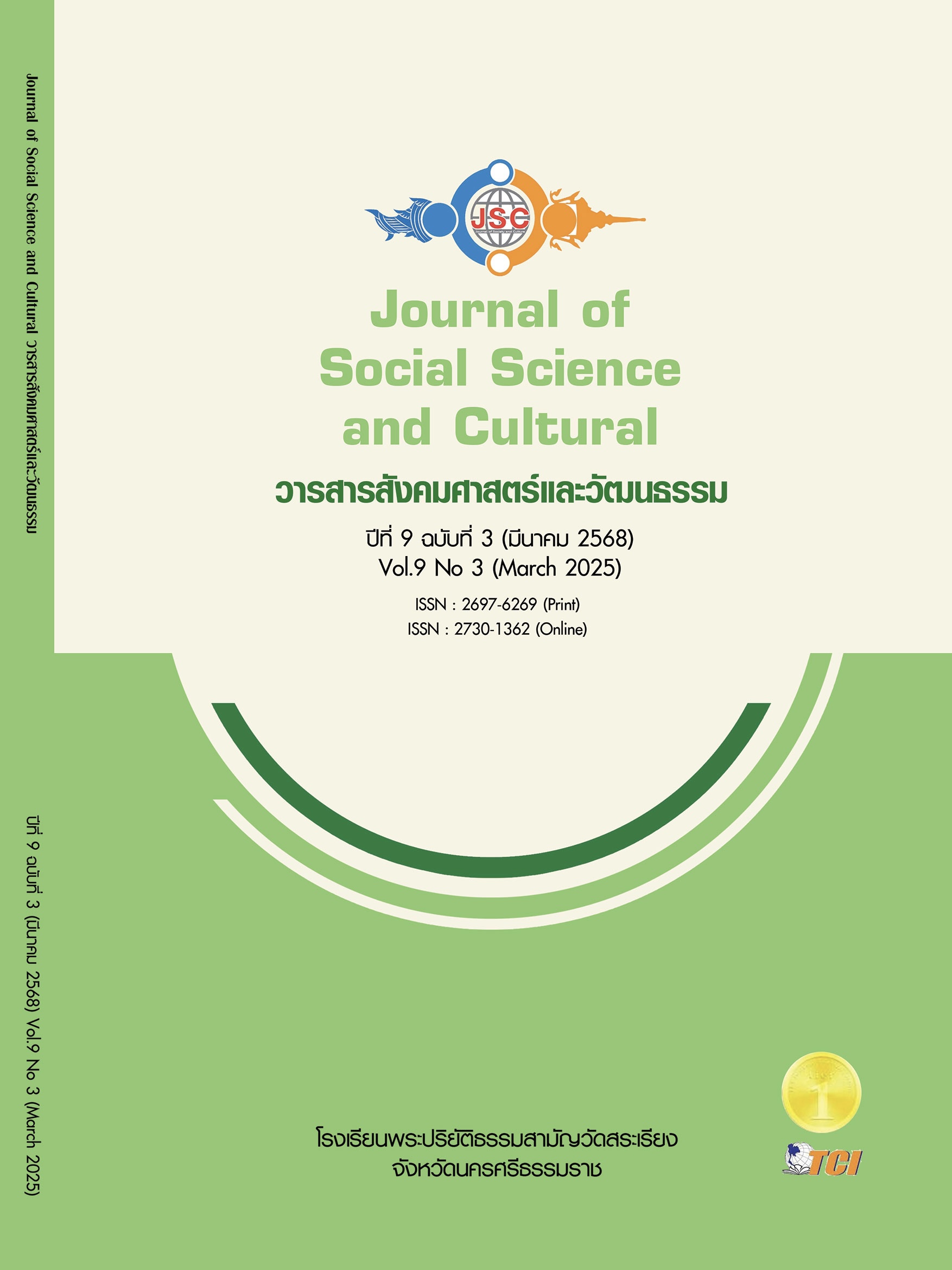PROMOTING THE MORALITY OF SOCIAL NETWORKS ACCORDING TO THE DECLARATION OF MORAL INTENT AND POLICY PROPOSALS FROM THE 13TH NATIONAL MORALITY ASSEMBLY
Main Article Content
Abstract
This study aims to: 1) Examine the input factors driving the moral commitments and policy proposals from the 13th National Moral Assembly, 2) Investigate the implementation outcomes of network organizations' initiatives in promoting morality in alignment with these policy proposals, and 3) Analyze the outcomes of network organizations in fostering morality based on the assembly’s commitments. This qualitative research employed data collection through record forms and interviews with key informants, including 91 representatives from network organizations and two officials from the Moral Center (Public Organization), which serves as the secretariat of the National Moral Promotion Committee. The findings reveal that key input factors include personnel, policies and plans, budget, network collaboration, communication and awareness, and the performance of six social network groups: government agencies, educational institutions, religious organizations, the private sector, civil society and community groups, and the media. These networks have engaged in activities aligned with the moral commitments declaration, such as network expansion, knowledge development, personnel recognition, and moral behavior development through various initiatives. Concurrently, they have advanced moral policy proposals. The implementation of various activities has yielded significant outputs, including an increased number of moral schools and coaching teachers, the establishment of more than 450 positive community leaders, over 200 model families, and the development of social-minded communicators. As for the outcomes, key achievements include government personnel demonstrating moral behaviors such as sufficiency, discipline, integrity, altruism, and gratitude; the establishment of a moral database for public organizations; the expansion of moral learning spaces; increased integration of religious principles for moral development; the promotion of morality through the collaboration of homes, temples, and schools; the recognition of morality as a provincial agenda; and the development of a social credit system to encourage virtuous behavior.
Article Details
References
กรมการศาสนา. (2565ก). แผนปฏิบัติการด้านการส่งเสริมคุณธรรมแห่งชาติ ระยะที่ 2 (พ.ศ. 2566 - 2570). กรุงเทพมหานคร: โรงพิมพ์ชุมนุมสหกรณ์การเกษตรแห่งประเทศไทย จำกัด.
กรมการศาสนา. (2565ข). คู่มือการขับเคลื่อนแผนปฏิบัติการด้านการส่งเสริมคุณธรรมแห่งชาติ ระยะที่ 2 (พ.ศ. 2566 - 2570). กรุงเทพมหานคร: โรงพิมพ์ชุมนุมสหกรณ์การเกษตรแห่งประเทศไทย จำกัด.
ธิฏิรัตน์ พิมลศรี และคณะ. (2563). โครงการวิจัย การสังเคราะห์รูปแบบ กลไกและแนวทางการปลูกฝังเจตคติและวัฒนธรรมสุจริตเพื่อการป้องกันและปราบปรามการทุจริต. นนทบุรี: สำนักงานคณะกรรมการป้องกันและปราบปรามการทุจริตแห่งชาติ.
ศูนย์คุณธรรม (องค์การมหาชน). (2567). งานสมัชชาคุณธรรมแห่งชาติ. เรียกใช้เมื่อ 30 มีนาคม 2567 จาก https://shorturl.asia/AWCBI
สำนักงานสภาพัฒนาการเศรษฐกิจและสังคมแห่งชาติ. (2565). ร่างแผนพัฒนาเศรษฐกิจและสังคมแห่งชาติ ฉบับที่ 13 (พ.ศ. 2566-2570). เรียกใช้เมื่อ 25 กุมภาพันธ์ 2568 จาก https://www.nesdc.go.th/ewt_news.php?nid=13651.
สุริยเดว ทรีปาตี และคณะ. (2563). โครงการพัฒนาตัวชี้วัดคุณธรรมเพื่อขับเคลื่อนสู่สังคมคุณธรรม. กรุงเทพมหานคร: สำนักงานการวิจัยแห่งชาติ (วช.).
Collins, R. (2004). Interaction ritual: Emotion, behavior, and society. New Jersey: Princeton University Press.
Creech, H. (2001). The role of knowledge networks in sustainable development. Winnipeg: International Institute for Sustainable Development (IISD).
Denhardt, J. V. & Denhardt, R. B. (2003). The new public service: Serving, not steering. New York: M.E. Sharpe.
Kohlberg, L. (1976). Moral Stage and Moralization: The Cognitive Development Approach Moral Development and Behavior. New York: Holt Rinehart and Winston.
Lofland, J. (1984). Analyzing Social Settings. Belmont, California: Wadsworth.
United Nations Development Programme (UNDP). (2009). UNDP Handbook on Planning, Monitoring and Evaluation for Development Results. Retrieved April 10, 2024, from https://www.endvawnow.org/en/articles/335-monitoring-and-evaluation-frameworks-3-parts.html

